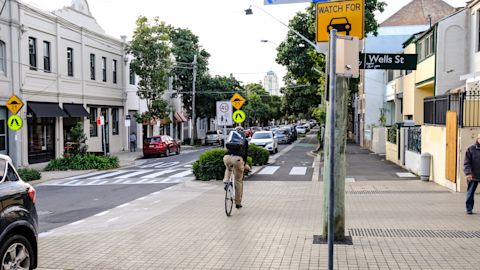Sydney’s cycleway network has more than 22km of separated bike lanes, giving bike riders safe access to all corners of the city. Here are some the features you’ll find on the network and tips for getting around smoothly.
Be prepared to give way at shared intersections

You’ll find shared intersections where a side street crosses a cycleway. They’re marked with a different surface treatment, plus a ramp for vehicles entering and leaving the intersection. You’ll see some of them on the Wilson and Bourke streets cycleways.
The rules for using them are simple. People walking have right of way over vehicles. And vehicles – bikes included – must give way to other vehicles already in the intersection, just like in a roundabout.
Slow down when approaching these intersections. This will give you more time to check the way is clear and give vehicles more opportunity to see you.
Use your bell early and often
This can help to warn people walking that you’re approaching or passing by. Footpaths alongside some cycleways in the city centre can be crowded and people are often hurried or distracted. Using your bell often and early is a way to get people’s attention and stop them stepping into the cycleway.
Be extra vigilant on cycleways that run against the flow of traffic. People crossing might be on the lookout for cars travelling from one direction and forget to check for bikes coming from the other.
Remember, every time you use your bell it’s a polite reminder that bikes are about.
Stop on the diamonds

Many intersections on separated cycleways have a dedicated traffic light for bikes. Stop on the diamond markings to activate the pressure pad and trigger the bike light sequence. If you roll off the diamonds, the sequence will reset and you won’t get a green light.
Hook turns and other uncommon markings

Some less common road markings on the bike network include hook turn boxes and the oddly named bicycle storage areas.
Hook turn boxes give you a safe space to wait, out of the flow of the cycleway, so you can make a turn across the traffic.
Bike storage areas are sometimes called advance stop lines, which is only slightly less confusing. These are special areas at intersections, between the parallel stop lines, where bikes can go to the front of the traffic queue to wait for the lights to change.
Don’t forget the shared paths too
Crash data over the past decade shows that separated cycleways reduce the number of incidents.
Separated cycleways offer a dedicated, protected area for bike riders, but you do not have to use them if you’re confident and happy to ride in a traffic lane.
As well as separated cycleways, there are more than 60km of shared paths in the city where bikes can ride. These are marked with a blue line and shared path symbol. Footpaths are a no-go unless you’re 16 years or under, or if you’re accompanying someone 16 years or under.
Published 4 May 2023, updated 5 May 2023



